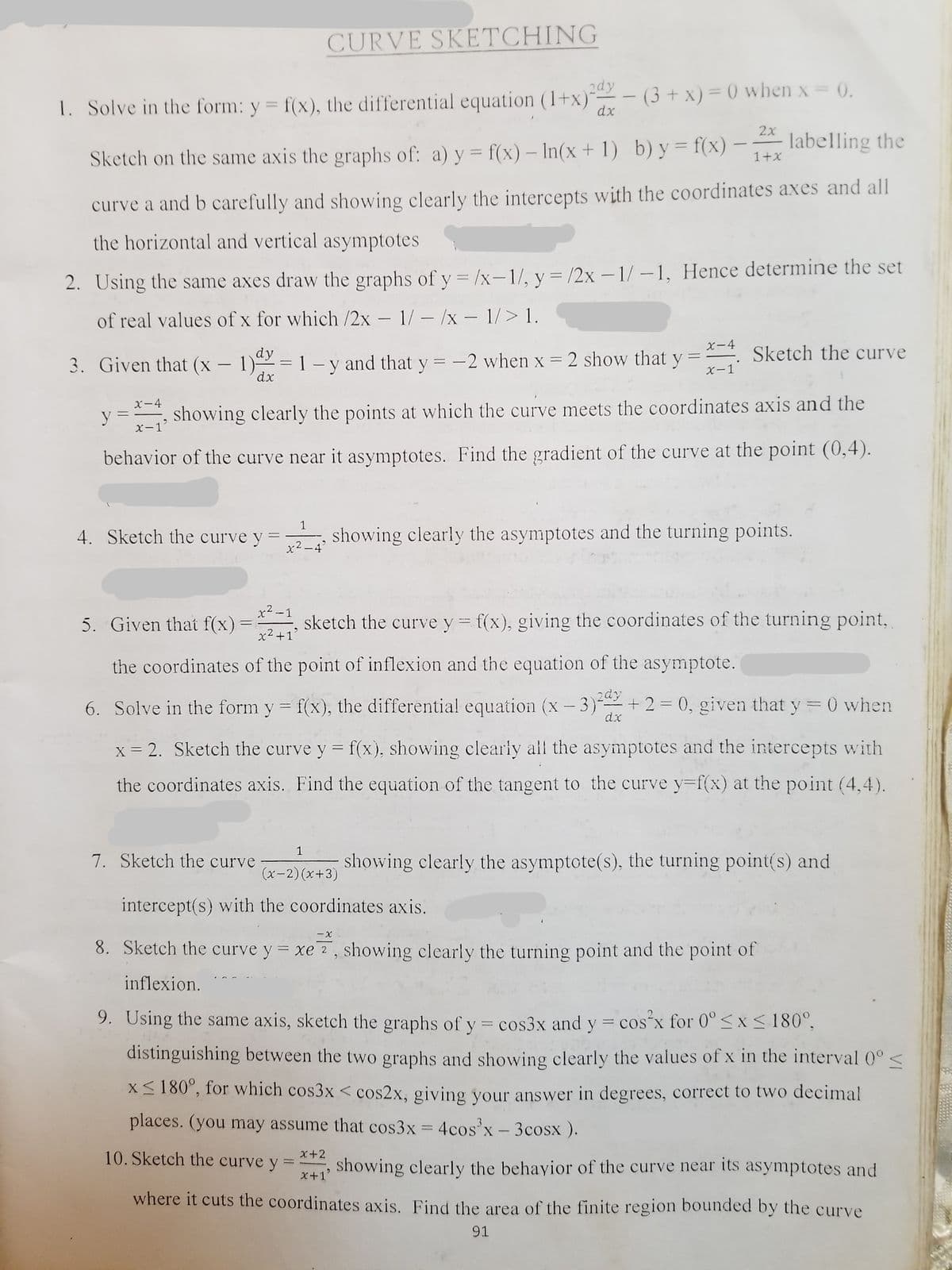Calculus: Early Transcendentals
8th Edition
ISBN:9781285741550
Author:James Stewart
Publisher:James Stewart
Chapter1: Functions And Models
Section: Chapter Questions
Problem 1RCC: (a) What is a function? What are its domain and range? (b) What is the graph of a function? (c) How...
Related questions
Concept explainers
Contingency Table
A contingency table can be defined as the visual representation of the relationship between two or more categorical variables that can be evaluated and registered. It is a categorical version of the scatterplot, which is used to investigate the linear relationship between two variables. A contingency table is indeed a type of frequency distribution table that displays two variables at the same time.
Binomial Distribution
Binomial is an algebraic expression of the sum or the difference of two terms. Before knowing about binomial distribution, we must know about the binomial theorem.
Topic Video
Question
Answer Q7, 8, 9

Transcribed Image Text:CURVE SKETCHING
1. Solve in the form: y = f(x), the differential equation (1+x)"
dx
2dy
- (3 + x) = ) when x = 0.
%3D
-
%3D
2x
labelling the
%3D
Sketch on the same axis the graphs of: a) y = f(x) – In(x + 1) b) y = f(x)
%3D
1+x
curve a and b carefully and showing clearly the intercepts with the coordinates axes and all
the horizontal and vertical asymptotes
%3D
2. Using the same axes draw the graphs of y = /x-1/, y= /2x – 1/ –1, Hence determine the set
of real values of x for which /2x – 1/- /x - 1/> 1.
X-4
dy
Sketch the curve
3. Given that (x -
dx
=1 - y and that y = -2 when x = 2 show that y
%3|
|
X-1
X-4
showing clearly the points at which the curve meets the coordinates axis and the
x-1
behavior of the curve near it asymptotes. Find the gradient of the curve at the point (0,4).
1
4. Sketch the curve y
showing clearly the asymptotes and the turning points.
x2 -4'
x² -1
5. Given that f(x)
sketch the curve y = f(x), giving the coordinates of the turning point,
x2+1
the coordinates of the point of inflexion and the equation of the asymptote.
6. Solve in the form y = f(x), the differential equation (x - 3) +2= 0, given that y =0 when
dx
x = 2. Sketch the curve y = f(x), showing clearly all the asymptotes and the intercepts with
the coordinates axis. Find the equation of the tangent to the curve y=f(x) at the point (4,4).
1
7. Sketch the curve
showing clearly the asymptote(s), the turning point(s) and
(x-2)(x+3)
intercept(s) with the coordinates axis.
8. Sketch the curve y = xe 7, showing clearly the turning point and the point of
inflexion.
9. Using the same axis, sketch the graphs of y = cos3x and y = cos x for 0°<x < 180°,
distinguishing between the two graphs and showing clearly the values of x in the interval 0° <
X<180°, for which cos3x < cos2x, giving your answer in degrees, correct to two decimal
places. (you may assume that cos3x = 4cos x- 3cosx ).
%3D
10. Sketch the curve y
X+2
showing clearly the behayior of the curve near its asymptotes and
X+1'
where it cuts the coordinates axis. Find the area of the finite region bounded by the curve
91
Expert Solution
This question has been solved!
Explore an expertly crafted, step-by-step solution for a thorough understanding of key concepts.
Step by step
Solved in 5 steps with 4 images

Knowledge Booster
Learn more about
Need a deep-dive on the concept behind this application? Look no further. Learn more about this topic, calculus and related others by exploring similar questions and additional content below.Recommended textbooks for you

Calculus: Early Transcendentals
Calculus
ISBN:
9781285741550
Author:
James Stewart
Publisher:
Cengage Learning

Thomas' Calculus (14th Edition)
Calculus
ISBN:
9780134438986
Author:
Joel R. Hass, Christopher E. Heil, Maurice D. Weir
Publisher:
PEARSON

Calculus: Early Transcendentals (3rd Edition)
Calculus
ISBN:
9780134763644
Author:
William L. Briggs, Lyle Cochran, Bernard Gillett, Eric Schulz
Publisher:
PEARSON

Calculus: Early Transcendentals
Calculus
ISBN:
9781285741550
Author:
James Stewart
Publisher:
Cengage Learning

Thomas' Calculus (14th Edition)
Calculus
ISBN:
9780134438986
Author:
Joel R. Hass, Christopher E. Heil, Maurice D. Weir
Publisher:
PEARSON

Calculus: Early Transcendentals (3rd Edition)
Calculus
ISBN:
9780134763644
Author:
William L. Briggs, Lyle Cochran, Bernard Gillett, Eric Schulz
Publisher:
PEARSON

Calculus: Early Transcendentals
Calculus
ISBN:
9781319050740
Author:
Jon Rogawski, Colin Adams, Robert Franzosa
Publisher:
W. H. Freeman


Calculus: Early Transcendental Functions
Calculus
ISBN:
9781337552516
Author:
Ron Larson, Bruce H. Edwards
Publisher:
Cengage Learning